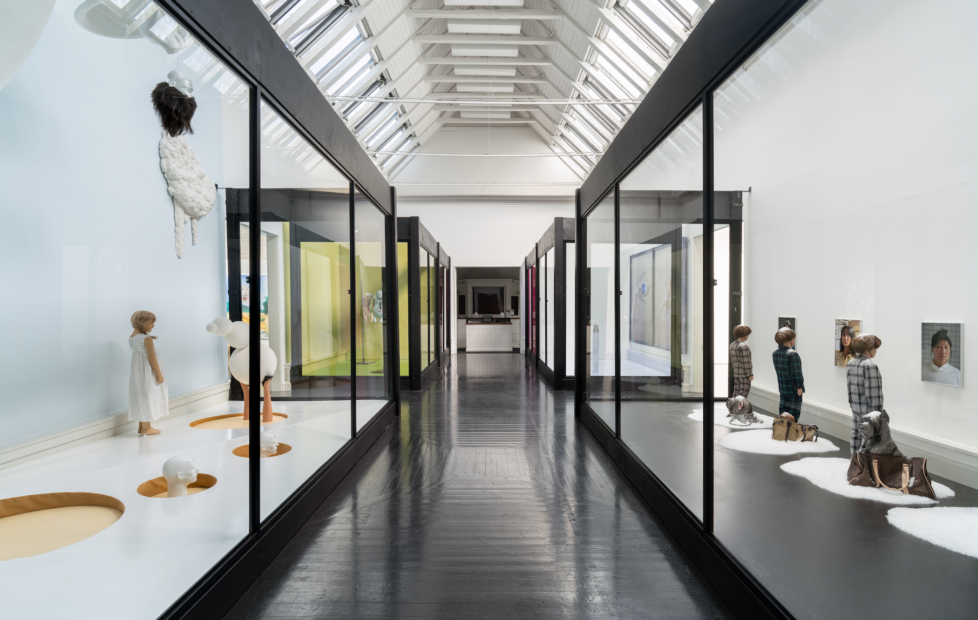
Claiming that the world’s first international Surrealist exhibition took place in Copenhagen may sound incredible. Nevertheless, this is the case. And it all happened at Den Frie Centre of Contemporary Art, where – having carried out one of those deep dives into its own history so characteristic of institutions today – the curator has pulled a fourteen-day exhibition called Cubism = Surrealism from 1935 out of the archives. As was typical of Den Frie’s rather loose, artist-driven organisation, the exhibition was not thoroughly documented at the time, meaning that it has stayed somewhat under the radar in the annals of art history. In other words, it is due for a revisit.
Aptly titled Another Surrealism, this revisit is (even on paper) quite a wet dream of an exhibition with its perfect ratio of major names from the original Surrealist movement and superstars from the international contemporary art scene supplemented by a solid sprinkling of figures from the younger local art scene.
Curator Anna Weile Kjær takes her point of departure in Walter Benjamin’s 1929 essay ‘Surrealism – The Last Snapshot of the European Intelligentsia’, which argued that the Surrealist method, which lets vastly different pictorial worlds collide in unexpected ways in order to bypass rational thought and give the subconscious free rein, grew out of the big cities of modernity. To Benjamin, the neon lights, advertising posters, abundance of goods, and ever-changing cityscapes were manifestations of the capitalist grip on the mind that artists wanted to change. But at the same time, they were images of the very method that could be used to achieve that goal.

We find that duality again in Another Surrealism and its emphatic cultivation of intersections between capitalism and desire, old-school commodity fetishism, and a vein of contemporary art that seems to celebrate the delectable object.
Installed down through Den Frie’s central axis is a shopping arcade with small separate displays of sexy installations behind glass. This decidedly naughty, tongue-in-cheek approach has historical antecedents: in 1947, Wilhelm Freddie’s Susanna and the Elders was installed in the display windows of the Copenhagen department store Magasin, an installation now reproduced in one of the shop windows at Den Frie. The work is a curious jumble of fragmented mannequins arranged in unnatural poses, some with shooting targets on their foreheads, establishing their own unsettling space poised between the seductive sphere of the shopping arcade and the brutality of the Second World War.
In the display window opposite Freddie, a number of child mannequins are arrayed with their backs turned towards the viewer and surrounded by objects and materials that clash against each other. They appear to be looking at a series of portrait photos on the wall – as if they were seeing themselves in the mirror. The work in question is John Miller and Nina Beier’s wonderfully complicated installation A True Mirror (2018–22), which not only mirrors Freddie’s installation, but also the viewer these figures so stubbornly ignore, all the while disrupting the illusory space – the arcade – so painstakingly and convincingly established by the curator.
The two shop windows are symptomatic of how effectively the encounters between the exhibition’s older works and present-day pieces are staged, all to utterly seductive effect. Improbable, yet entirely effortless connections are made between unauthorised commercial objects based on Dali’s melting watches and Bunny Rogers’s luminescent perfume; between Vilhelm Bjerke Petersen’s constructed dream images from 1935–36 and Rolf Nowotny’s eerie, if not downright uncanny tableau with a flashing head and a living bed from 2022; and between the methods applied in Isa Genzken’s Schauspieler sculptures and Mira Winding’s doodles on café napkins. Once I’ve looked at Nina Beier’s cool oversized cocktail glasses (in which images from digital stock photos are recreated in three dimensions) as examples of what Weile Kjær calls “capitalist Surrealism,” it is impossible to get that reading out of my head again.
While the exhibition takes a respectful approach to the established, classic readings of the older works, we might object that the present-day works of art are subjected to rather strict control. Another Surrealism is unafraid of appearing tightly curated and is quite happy to ignore certain aspects of the featured artworks in order to form links between practices that few would have placed in the same room. To me, this shows a fundamental belief in the inherent strength of the works presented as well as a playful, light-hearted approach to curation that is perfectly willing to present a rushing river of ideas and connections, yet never sets any of them in stone.
Theoretical connections presented in the exhibition’s excellent handout flourish in the actual presentation and installation of the works, with the shopping arcade as the absolute highlight. Not to mention the sheer delicacy with which older works insert themselves among small ceramic pieces in Soshiro Matsubara’s textile labyrinth, how exquisitely Rikard Thambert’s double sculpture Armslength (2019) stands like two awkward sphinxes on either side of a passage, or how coarsely amusing it is to see Esben Weile Kjær’s hulking pink mess of a human-sized poodle snarling at Harry Carlsson’s Core of the Poodle (1936).
Another Surrealism is a wonderful exhibition: as complicated, deep, cheeky, bold, and sexy as Tora Schultz’s red patent leather Prada stilettos. It touches on some of the questions about contemporary art that I myself have had the hardest time articulating. Why do visual artists decorate Hermès stores? What happens to all the artist merchandise that is constantly being produced? And how might we understand a younger generation that seemingly embraces the expressions of capitalism while claiming that this will set them free?















